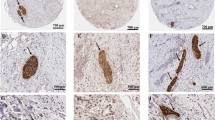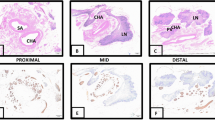Abstract
The peptidergic/aminergic innervation of normal liver and tumour blood vessels was investigated in order to determine vascular control with a view to improving the efficacy of hepatic arterial cytotoxic infusion in the treatment of colorectal liver metastases. Selected areas of liver metastases and macroscopically normal liver from resection specimens (n = 13) were studied using light microscope immunohistochemistry for the presence of protein gene product 9.5 (PGP), vasoactive intestinal polypeptide (VIP), neuropeptide Y (NPY), calcitonin gene-related peptide (CGRP), substance P (SP) and tyrosine hydroxylase (TH). The ultrastructure of blood vessels supplying liver metastases and their perivascular innervation were also examined by transmission electron microscopy. In the normal liver, perivascular immunoreactive nerve fibres containing PGP, NPY and TH were observed around the interlobular blood vessels and along the sinusoids and the central vein of the hepatic lobule. The greatest density of immunoreactive nerve fibres was seen for PGP, followed (in decreasing order) by NPY and TH. VIP, SP and CGRP immunoreactivity was observed only in nerve bundles associated with the large interlobular blood vessels. In contrast, no perivascular immunoreactive nerves were observed in colorectal liver metastases. Electron microscopy confirmed the absence of perivascular nerves in liver metastases. In addition, it showed that the walls of these blood vessels were composed of a layer of endothelial cells surrounded by an incomplete or, very rarely in the periphery of the tumour, a complete, layer of synthetic phenotype of smooth muscle-like cells. These results imply that the blood vessels supplying liver metastases are bereft of normal neuronal regulation; whether there is a role for endothelial cell control of blood flow in these vessels is not yet known.
This is a preview of subscription content, access via your institution
Access options
Subscribe to this journal
Receive 24 print issues and online access
$259.00 per year
only $10.79 per issue
Buy this article
- Purchase on Springer Link
- Instant access to full article PDF
Prices may be subject to local taxes which are calculated during checkout
Similar content being viewed by others
Author information
Authors and Affiliations
Rights and permissions
About this article
Cite this article
Ashraf, S., Crowe, R., Loizidou, M. et al. The absence of autonomic perivascular nerves in human colorectal liver metastases. Br J Cancer 73, 349–359 (1996). https://doi.org/10.1038/bjc.1996.60
Issue Date:
DOI: https://doi.org/10.1038/bjc.1996.60
This article is cited by
-
Purinergic signalling and cancer
Purinergic Signalling (2013)
-
Epinephrine-infused CTHA for HCCs
Abdominal Imaging (2008)



